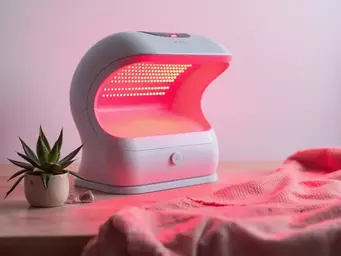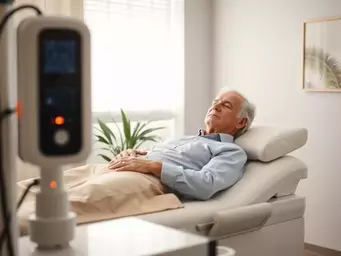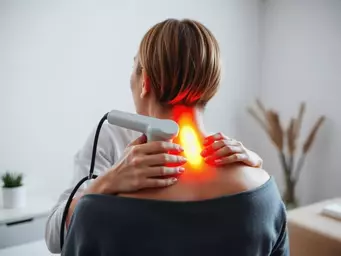FDA-Cleared
Ensures safety & efficacy.

Curious about how light can significantly enhance healing? Low-level laser therapy (LLLT) is a groundbreaking approach that taps into the power of light to stimulate cellular activity and promote recovery. This innovative treatment is gaining momentum, and understanding its benefits could be your key to managing pain and accelerating healing.
Low-Level Laser Therapy (LLLT) promotes healing through several key mechanisms, stimulating cellular activity and reducing inflammation. The visual below highlights these core processes and their outcomes.
FDA-Cleared
Ensures safety & efficacy.
Non-Invasive
No downtime, minimal side effects.
Quick Treatment
Sessions usually a few minutes.
At Erchonia Laser, we are passionate about demystifying low-level laser therapy (LLLT) and its potential to transform healing. But what exactly is LLLT? Simply put, it’s a non-invasive treatment that uses specific wavelengths of light to stimulate cellular function. This method is gaining recognition for its ability to promote healing and manage pain effectively. Whether you’re a healthcare professional or a patient seeking relief, understanding LLLT is the first step toward harnessing its benefits!
Many people are curious about how this technology can assist in their recovery. LLLT is based on the principle of photobiomodulation, which refers to the way light interacts with biological tissues to encourage healing processes. By increasing cellular activity, LLLT helps reduce inflammation and pain, making it a valuable tool in modern medicine.
Low-level laser therapy is often described as a gentle, non-invasive treatment that utilizes low-intensity lasers or light-emitting diodes (LEDs). These devices emit light at specific wavelengths, which penetrate the skin. What's remarkable is that LLLT does not generate heat, making it a safe option for patients. Here are some key points to remember:
As we embrace the growth of LLLT, it’s essential to acknowledge its role in healthcare. It not only provides relief for various ailments but also empowers patients by offering a non-invasive solution to chronic conditions.
Understanding the science behind photobiomodulation can be fascinating! When light from LLLT interacts with cells, it triggers a series of biochemical reactions that enhance healing. This process increases the production of molecules like adenosine triphosphate (ATP), which are vital for cellular energy and repair. Isn't it incredible how light can literally revitalize our cells?
Moreover, LLLT helps to improve blood flow and reduce oxidative stress. This combination accelerates the healing process and alleviates pain, making it a game-changer in pain management and recovery. As we explore LLLT further, we’ll uncover how it works to facilitate healing in deeper detail.
It's exciting to think about the mechanisms behind LLLT and how it helps speed up healing! At Erchonia Laser, we emphasize the importance of understanding these mechanisms to fully appreciate the therapy's benefits. Let’s dive into how this innovative treatment works.
The primary mechanism of LLLT involves the stimulation of cellular activity. When laser light penetrates the skin, it activates various cellular functions that play a crucial role in healing. Here are a few key mechanisms:
Understanding these actions allows us to appreciate how LLLT can effectively support the body's natural healing processes. It’s like giving your cells a gentle nudge to get back to work!
Fibroblasts are specialized cells that play a critical role in tissue repair. By producing collagen and other extracellular matrix components, they help to rebuild damaged tissues. LLLT energizes these fibroblasts, leading to faster and more effective tissue regeneration. For a deeper understanding of cellular function and repair, this study on photobiomodulation provides further insights.
The benefits of stimulating fibroblast activity extend to various conditions, including injuries and surgical recovery. By enhancing fibroblast function, LLLT helps ensure that healing occurs more efficiently, reducing recovery time for patients. Isn’t that a powerful advantage?
Another vital aspect of LLLT is its impact on mitochondrial function. Mitochondria, often referred to as the powerhouses of the cell, are responsible for producing ATP. LLLT enhances mitochondrial activity, leading to increased ATP production, which is essential for cellular repair and regeneration.
This boost in energy allows cells to recover more quickly, ultimately translating to faster healing and improved overall health. In a world where we often seek instant solutions, LLLT offers a remarkable way to naturally facilitate recovery.
ATP production is at the heart of cellular energy and metabolism. The more ATP our cells produce, the more efficient they become at repairing damage and maintaining normal function. With LLLT, patients benefit from enhanced ATP levels, allowing their bodies to take charge of the healing process.
As we continue to study LLLT, the importance of ATP in healing becomes increasingly clear, underscoring its role as a cornerstone of effective therapy. This natural energy boost is one of the many reasons why I’m such a strong advocate for low-level laser therapy!
Reducing inflammation and managing pain are critical components of healing, and LLLT excels in both areas! By targeting the sources of inflammation, LLLT provides relief to those suffering from chronic pain conditions. Let’s explore how it achieves these goals.

This multi-faceted approach not only alleviates pain but also promotes overall wellness, making LLLT a valuable addition to any treatment plan.
One of the most significant benefits of LLLT is its ability to enhance circulation. Increased blood flow means more oxygen and nutrients reach the injured tissues, promoting healing and recovery. With improved circulation, patients often experience quicker relief and a more comfortable healing process.
As someone who’s witnessed the positive outcomes of LLLT firsthand, I can confidently say that improved circulation is a game changer in pain management!
Unlike traditional treatments that may involve invasive procedures or lengthy recovery times, LLLT offers a non-invasive alternative that is safe and effective. With minimal side effects and no downtime, patients can resume their daily activities almost immediately after treatment.
This convenience paired with its proven efficacy is what makes LLLT particularly appealing to those seeking relief from chronic pain or injuries. At Erchonia Laser, we focus on providing these innovative solutions to enhance patient outcomes.
LLLT’s ability to address inflammation directly correlates with its effectiveness in pain relief. By reducing swelling and irritation, patients often find a significant decrease in discomfort. This dual benefit sets LLLT apart from other therapies, making it a preferred choice for many.
By integrating LLLT into treatment plans, healthcare providers can offer a powerful tool for managing pain without relying solely on medications or invasive procedures. Isn’t it reassuring to know that healing can be facilitated through such a gentle approach?
To maximize the benefits of low-level laser therapy (LLLT), consider combining it with other healing modalities, such as physical therapy or acupuncture. This integrated approach can enhance recovery times and improve overall treatment outcomes, allowing your body to heal more effectively.
As we dive deeper into the effects of low-level laser therapy (LLLT), it’s important to recognize its profound impact on healing. Not only does LLLT offer immediate pain relief, but it can also provide long-term benefits that enhance the quality of life for many patients. Research has shown that LLLT is a valuable tool in both pain management and recovery, making it a versatile option for a variety of conditions.
In my practice with Erchonia Laser, I’ve witnessed firsthand how patients respond positively to LLLT. The science behind this therapy is well-supported by ongoing studies, which continue to validate its efficacy and safety. By understanding the lasting effects of LLLT, we can better appreciate its role in modern healing methodologies.
Recent studies have shed light on the long-term benefits of LLLT, highlighting its safety profile and effectiveness. Some key findings include:
These findings underscore the reliability of LLLT as a non-invasive treatment method. It’s reassuring to see that ongoing research, such as this detailed review on LLLT for pain, continues to support the use of LLLT for various conditions, further solidifying its place in pain management and recovery.
Numerous clinical studies have provided compelling evidence of LLLT's benefits in pain management and recovery. As a passionate advocate for this treatment, I am thrilled to see such positive outcomes documented:
These clinical insights not only validate the effectiveness of LLLT but also highlight the importance of integrating this therapy into standard treatment protocols. As I continue to educate healthcare professionals about LLLT, I emphasize the growing body of research backing its use.
At Erchonia Laser, one of the most rewarding aspects of my work is hearing success stories from patients who have undergone LLLT. Their testimonials highlight the transformative effects this therapy can have. Here are a few examples:

These real-life experiences underscore the potential of LLLT to enhance healing and improve overall wellness. Listening to these stories not only inspires me but also reinforces the mission of Erchonia Laser to empower individuals with knowledge about this innovative therapy.
Now that we've explored the impact of LLLT on healing, it’s essential to consider how to access this treatment. Taking the right steps can make all the difference in your recovery journey!
When seeking LLLT treatment, finding a qualified practitioner is crucial. Look for professionals who:
Finding the right practitioner can enhance your treatment experience and outcomes.
Understanding the financial aspects of LLLT is also important. Here are some considerations:
Being informed about costs can help you make better decisions regarding your treatment.
Finally, integrating LLLT into your physical therapy or rehabilitation plan can yield impressive results. Here’s how it can fit into your journey:
By incorporating LLLT into your recovery plan, you’ll be taking an informed step towards achieving your wellness goals! Together, let’s explore how this innovative therapy can benefit you on your path to healing.
Here is a quick recap of the important points discussed in the article:
Understanding Red Light Therapy

Curious about how light can play a pivotal role in healing? The world of light therapy is rich with
Erchonia Laser Therapy for Pain Management

Curious about a non-invasive solution to chronic pain? Erchonia Laser Therapy is emerging as a revol
Relieving Neck and Shoulder Pain

Consider this: neck and shoulder pain affects millions, yet many are unaware of the root causes. Und
Understanding Red Light Therapy
Erchonia Laser Therapy for Pain Management
Relieving Neck and Shoulder Pain
Erchonia Laser and Back Pain Outcomes
Exploring Erchonia's Laser Technology Science